Design Tasmania
Corner of Brisbane and Tamar streets
Launceston, 7250
Tasmania
info@designtasmania.com.au
+61 3 6331 5506
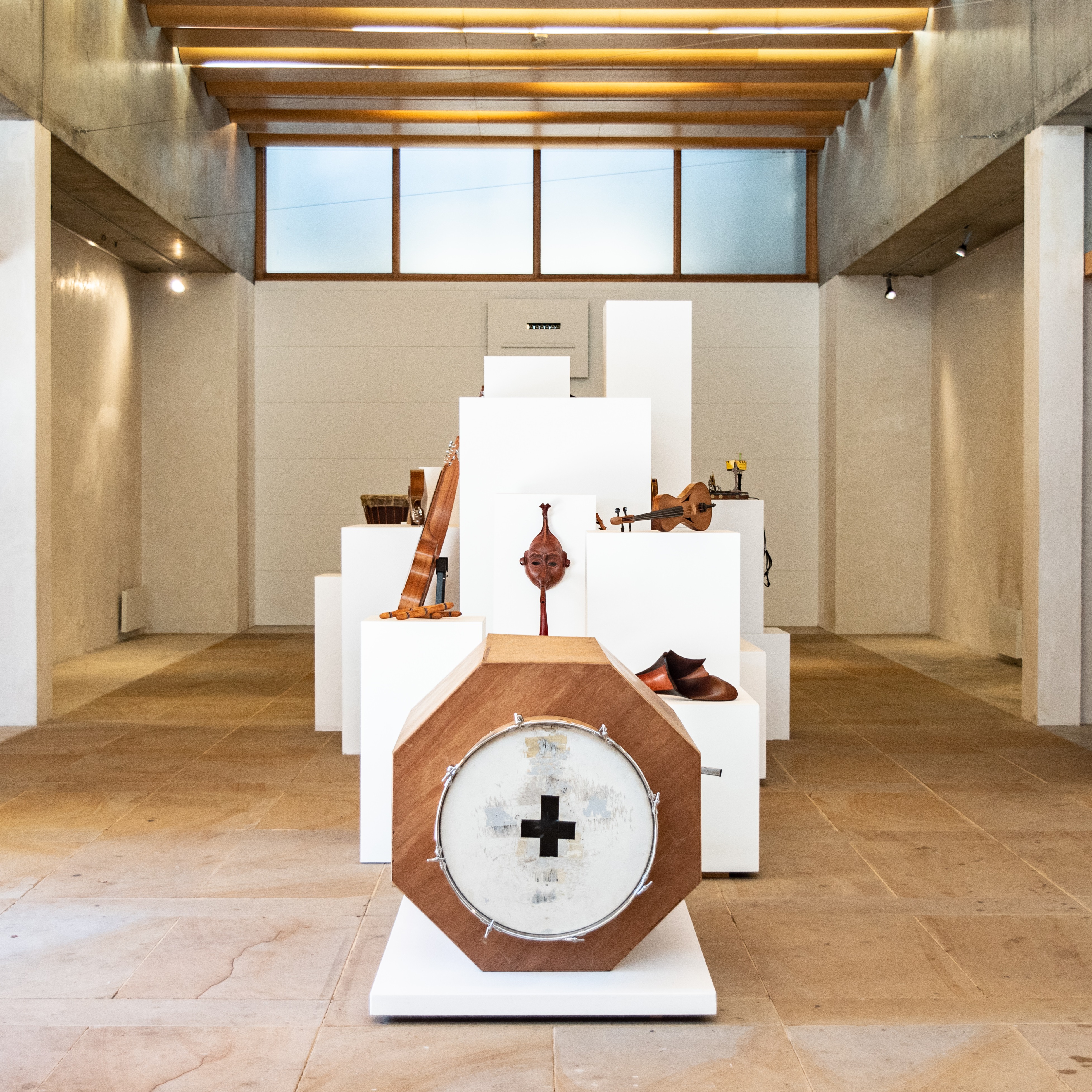
Organology
21st January - 17th April 2022
Organology: the science of musical instruments and their classifications. This collection of curious and master-crafted instruments all relate to Tasmania in some way. Electrophones, aerophones, membranophones, idiophones and chordophones.
Curated by Natalie Holtsbaum + Presented for Mona Foma 2022.
Featuring:
Mat Ward | Dylan Banks | Scot Cotterell | Martin Blackwell | Garry Greenwood | Marcus Tatton | Dan Magnus | Emily Sheppard | Roger Bodley | Chris Henderson | Daniel Brauchli | Grant Maddock | Paul Barter | Mark Gilbert | Rex Greeno.
Image: Juanny Tan
Catalogue

Kelp Violin; photo courtesy of Chris Henderson.

Intonarumori Organology; photo by Mat Ward.

Daniel Brauchli, Cittern Guitars; photo by Juanny Tan.
Curator's Statement: Natalie Holtsbaum
Is music a more profound way of connecting than verbal or written language?
Organology can help us explore answers to that question. It’s the science of musical instruments and their classifications – embracing the history of instruments, how they are used across cultures, and technical questions about how instruments produce sound and more.
Organology is a close companion to ethnomusicology – examining the form, context, performance environment, and the interrelationship between instrument, performer and sound object.
This exhibition foregrounds how musical instruments hold and deliver significant social value.
Garry Greenwood’s leather orchestra connects a thriving ensemble of wind instrument musicians – as guardians of a wider collection. Modifications to existing instruments open questions around new genres, including experimental musical instruments where the process of making sound is reconsidered.
Today we know that music stimulates neural pathways that build empathy, trust, and cooperation.
Can the thrill of connection through music drive more of us to approach this COVID pandemic differently – to look it straighter in the eye? Dive more deeply into ourselves? Be bolder and even more intentional in our actions?
Can we move beyond our fears about attending musical performances with many people – who we fear as strangers, even as vectors of infection?
Is it possible to surrender to the shared experience of being moved by the same beat – and experience the poetic complexities of lyric meeting melody?
Can this help us break down social prejudices and consumption practices – to co-create more common ground?
Can this enable our better acknowledgment of Tasmanian designers who have focused on instruments of sound?
Their work hones traditions of master craftsmanship, making and application of engineered mechanics either by adhering to tradition or intentionally challenging preconceptions of what a musical instrument can be.
Through these works, some designers celebrate the distinctive tonality of Tasmanian timbers – whose density of grain can generate an exceptional velocity of sound … transmitting a vibrational energy. Others look more specifically to the components and expose their workings.
All that’s more needed than ever, for all of us, right now.

Organology; photo by Juanny Tan.
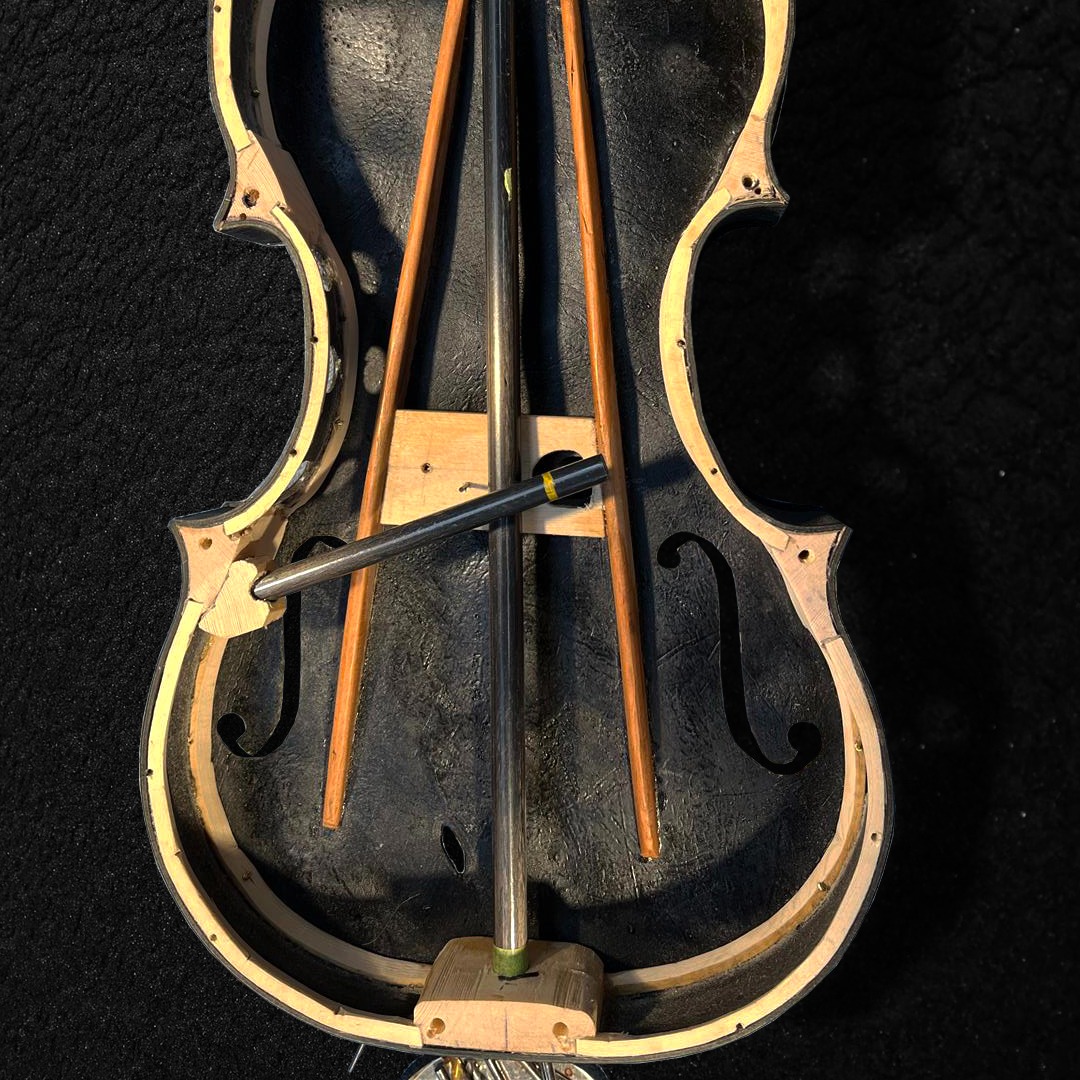
Kelp Violin; photo courtesy of Chris Henderson.
Kelp Violin
Chris Henderson
This kelp violin is made from Tasmanian bull kelp (durvillaea potatorum) which grows on the west coast of Tasmania.
“Making a violin is a gift from the luthier to the musician, and above all to the music. For me there is something captivating about listening to an instrument that started life as discarded kelp washed up on a wild beach.”
Making a Kelp Violin
Interview with Chris and Roger
Making a Kelp Violin
Kelp Amplifier + Kelp Eel Drum
Emily Sheppard
A dive into the chilly waters of coastal Tasmania is rewarded by a mesmerising underwater environment; dappled light through ever-swaying seaweeds, and chance encounters of organisms big and small that take your breath away. Diving deeper down, beneath the canopy, you are greeted by a mysterious world of brightly coloured seaweeds, marine lichens and anemones. A rich landscape for artistic inspiration.
Seaweed forests are ancient ecosystems for which many organisms have come to rely on. Around one billion years ago, long before land ecosystems were full of trees, scented flowers and humans, the very first seaweeds emerged: multi-cellular, branched, and micro. Seaweeds photosynthesise, absorbing carbon dioxide and releasing oxygen, in the same way as plants and trees. This provides an essential service for the many oxygen-requiring animals on Earth; fundamental to our every breath. Seaweed forests also provide food and shelter for marine invertebrates and fish, whose waste in turn provides nutrients to fuel seaweed growth.
For tens of thousands of years, seaweeds and kelps have been used by First Nations people in lutruwita/Tasmania, as a valuable and diverse resource for many different aspects of life. These kelp instruments remind us of our complex dependence on and relationship to natural systems. With ocean waters warming increasingly every year, seaweed forests are shrinking. These beautiful and necessary ecosystems may too soon become a museum piece.
Kelp Amplifier Audio: WindTides
Making a Kelp Amplifier
Kelp Amplifier

Kelp Amplifier; photo courtesy of Emily Sheppard.
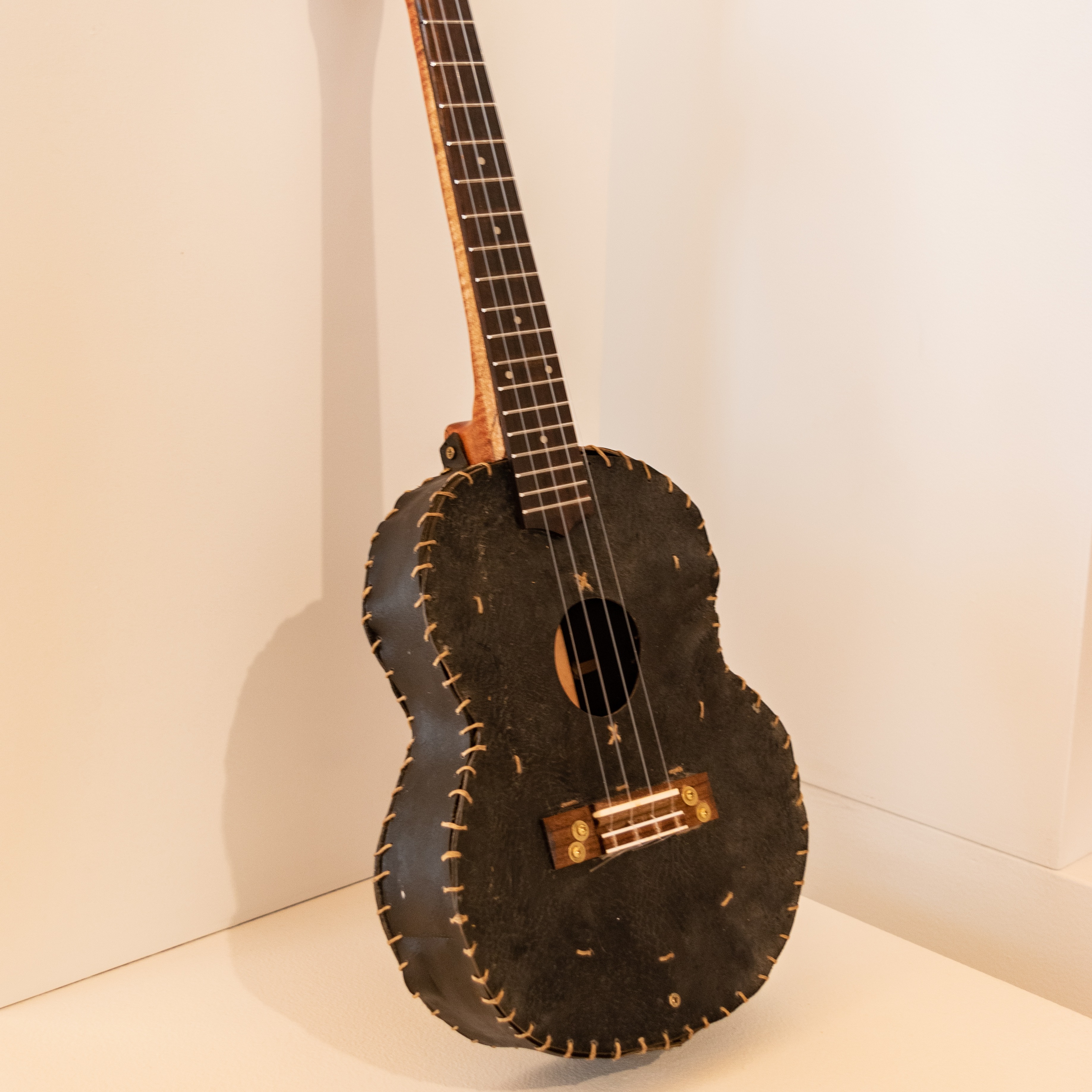
Roger Bodley, Kelp Ukelele; photo by Juanny Tan.
Kelp Violin + Ukelele
Roger Bodley
Embarking on making a kelp violin was the result of a challenge issued by Emily after a BIGhArt musical event in the Tulip Farm as she demonstrated how her hollow kelp resonator was extremely rigid and resonant. The fronds of bull kelp were gathered from Marrawah and West Point in Circular Head, NW Tasmania.
Fresh kelp is thick, flexible and slippery, almost slimy, and cannot be glued, so I cut the parts and sewed them with beeswaxed hemp twine.
Over the next four weeks as the kelp dried out, it shrank asymmetrically, eventually becoming a small shrivelled box - “the Walnut” - which needed an exoskeleton to support the tension of the strings.
The remainder of the kelp was frozen to preserve it but when I checked a few days later, it was apparent that the water had left the kelp, which was 60-70% thinner, and formed a 2-3mm sheet of ice either side of the now leathery kelp and could be easily separated. As it fully dried, however, it shrank and distorted further so final shapes were unpredictable.
We found that it had excellent thermoplastic properties and were able to heat it and subsequently mould and cut it easily with a hot air gun. The fresh kelp was therefore cut about 30-40% oversize, dried out in the freezer and clamps until rigid and then cut and moulded to size and shape using the gun.
String tension was supported with an internal spine and a later version also had a carved blackwood neck and scroll - “The Dolphin”.
Two ukuleles were also made with a similar technique but as the string tension cannot be carried over to the tail, considerable support strengthening was needed that had to be stitched in as no glues were effective.
All surfaces were covered with a burnishing oil as the kelp is still very vulnerable to humidity and consequent distortion.
‘Djembe’ Log Drum
Marcus Tatton + Dan Magnus
The log drum ‘Djembe’ is an adaptation of the West African Djembe found predominately in Ivory Coast, Mali, Guinea and Senegal. By hollowing the drums from solid logs of Tasmanian rainforest woods, the log drum ‘Djembe’ is long lasting and maximises the resonant qualities of the native timbers. The ‘Djembe’ design has an exceptionally wide dynamic range, making it an expressive and adaptable percussion instrument, applicable to both contemporary and classical music.
Log Drums Percussion developed in 1988 when Dan Magnus and Marcus Tatton collaborated to build an experimental wooden hand drum, while training at the Centre for Furniture Design in Hobart. Log Drums Percussion became a fulltime business in 1990 and continued for eight years. Magnus and Tatton produced a variety of traditional and customised percussion instruments, sought by contemporary and classical musicians throughout Australia and overseas. The endevour was deliberately kept small scale in order to maintain contact with the individual musician’s needs. Dan and Marcus would camp for weeks to source the waste log off cuts used for the drums, which they would carve initially with chainsaws on site. Back at the studio the drums were completed, including kiln drying, carving and tensioning of the skin across the drum.
The 'Djembe' is part of the Design Tasmania Wood Collection.
View
Marcus Tatton
Dan Magnus
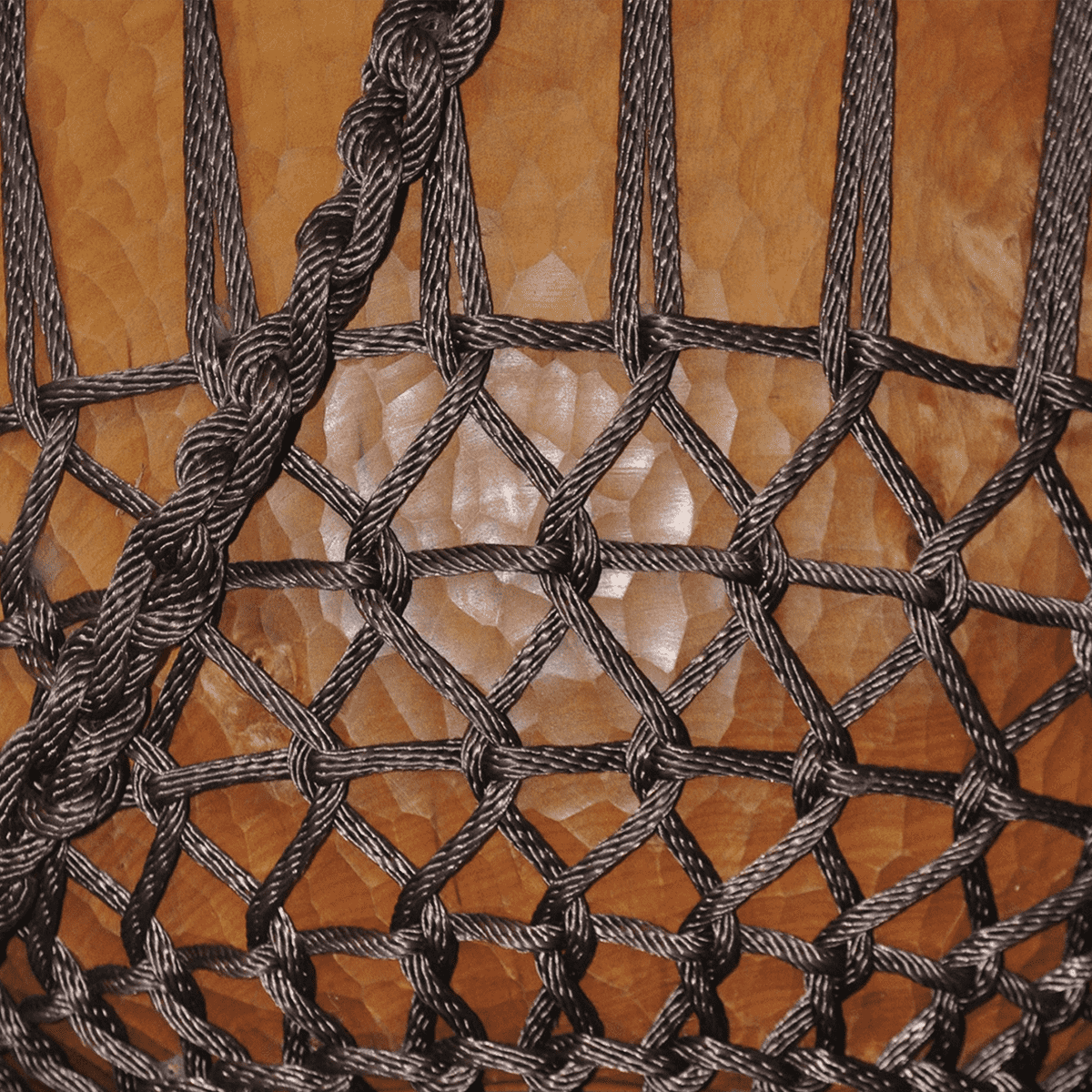
Marcus Tatton, Djembe Log Drum; photo by Peter Whyte Photography.
Slide Guitar #164
Daniel Brauchli
Daniel’s acoustic slide guitars are an original design. The fixed bridge guitars have a huge sustain and full bass, especially suitable for solo playing.
Daniel made his first instruments when he was 17 and over the following years has made heaps of fretted instruments with help and input from numerous makers. As a multi- instrumentalist he has always interested in instruments from different cultures and periods.
View Daniel playing his Slide Guitars on Youtube:
Cakewalk Into Town Taj Mahal
Possum Up A Gum Stump
Brauchli Slide Guitar

Slide Guitar; photo courtesy of Daniel Brauchli.
Guitar #178
Daniel Brauchli
Engineering, electronics and most modern design disciplines are driven by the need to be constantly better than what went before. Acoustic musical instruments on the other hand don’t seem to have much evolutionary force driving their development. Most musicians want to play copies of the instruments that their heroes in the past played, which were usually designed for cheap factory production.
Unlike strumming guitars that focus on the top and bottom frequencies, Daniel’s guitars are designed to have a loud balanced tone that is continuous across the whole range like a good mandolin or violin. This is a big asset for finger picking, lead playing, and studio recording.
View Daniel playing his Guitars on Youtube:
Jingo
Oh Suzanna

Guitar #178; ; photo courtesy of Daniel Brauchli.
Cittern Guitar #209 & Small Cittern Guitar #217
Daniel Brauchli
The cittern guitar is not that different to Daniel’s normal guitar. It simply has a single bout instead of a double bout guitar shape. By using full phase carbon bracing these small instrument deliver a huge sound. The main reason for the design is the accessibility of the neck and the physical balance of the instrument. It needs to be played with a strap, which could be seen as a negative, but Daniel sees it as a positive because draping a guitar over your leg is a poor playing position and creates bad habits like hanging on to the neck.
View Daniel playing his Cittern Guitars on Youtube:
Large Cittern 1
Large Cittern 2
Small Cittern 1
Small Cittern 2

Cittern Guitar #209; photo courtesy of Daniel Brauchli.

Small Cittern Guitar #217; photo courtesy of Daniel Brauchli.

Daniel Brauchli, Cittern Guitar; photo by Juanny Tan.

Daniel Brauchli, Cittern Guitar; photo by Juanny Tan.
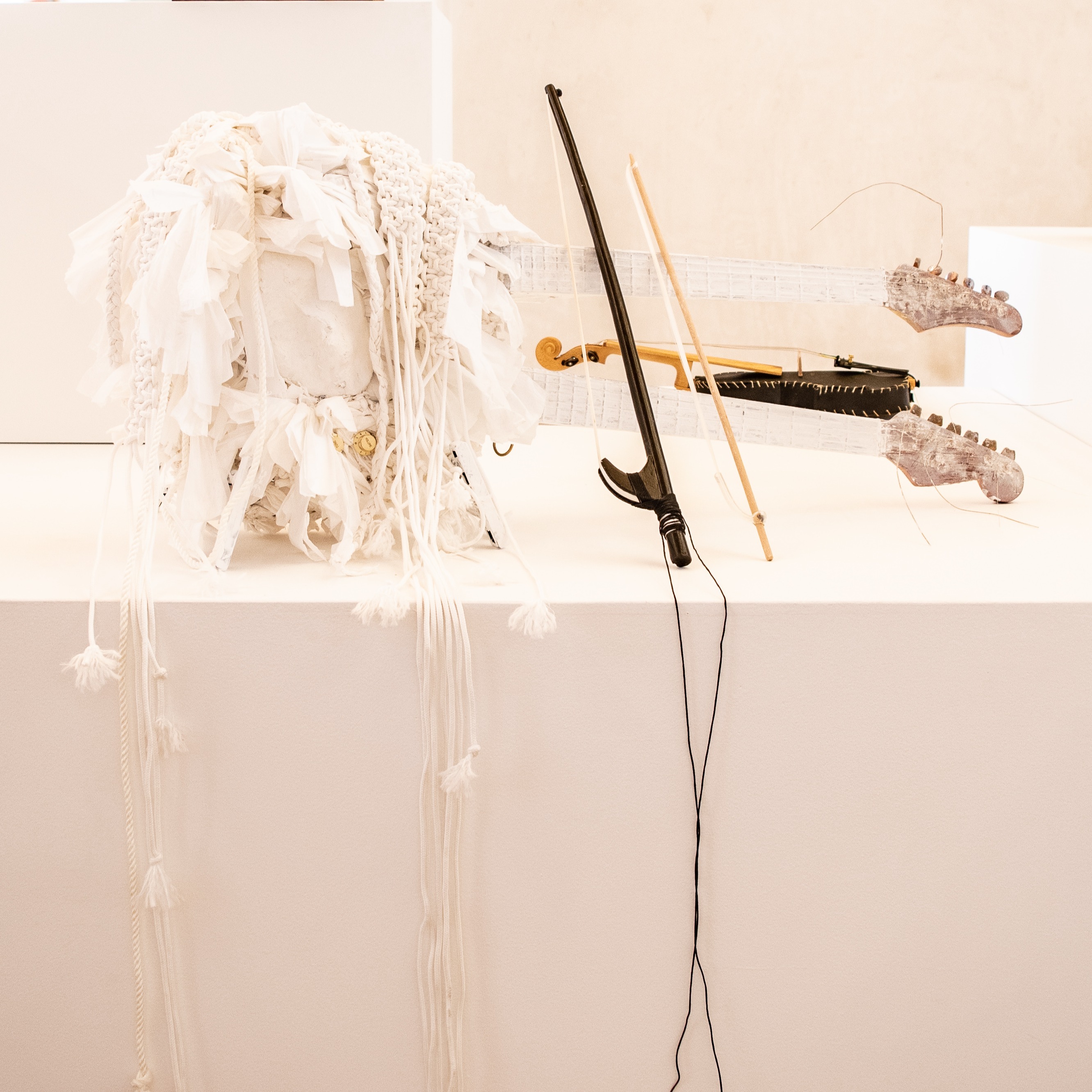
Martin Blackwell, Kono Gita o-Haijiku. Photography by Juanny Tan.
Kono Gita o-Haijiku
Martin Blackwell
In respects to this instrument, I was really drawn to creating an art piece that would invoke curiosity and wonderment - in the sense of providing a wholly esoteric musical item - contrasting radically with otherwise more familiar instruments
As an artist, I work in textile and am an avid student of Tekuniku (art of Japanese textile making). All the while, researching traditional methods of Japanese inspired tapestry, knotting and weaving, such as Furoshiki (wrapping), Hojojutsu (rope art), Mitzuhiki (paper tying) and Kumihimo (braiding)
To re-purpose the double necked guitar (which was used for live shows with the band Elvis Christ between 2006 – 2012) I combined all techniques utilising recycled plastic and string materials, with an emphasis of white x white.
The strings on the guitar necks are tuned F#, F#, F#, F#, A, F#. A death mask has been added in plaster to make the guitar look that little but more metal!
Intonarumori B + H
Mat Ward + Dylan Banks
Intonarumori were first built by the Futurist Artist Luigi Russolo in 1913. Russolo envisaged a new contemporary music that reflected the sonic environment of the early 20th Century which was shaped by the noise of industry. They are capable of a wide variety of sounds ranging from harsh industrial noise through to whisper-like ambience.
The instruments work via friction created between a wire and a rotating cylinder. The wire is attached to a drum head which acts as a speaker. The other end of wire connects to a lever that controls the pitch of the sound through tightening the tension. The cylinder is rotated against he wire via a hand controlled external crank.
All of Russolo’s original machines were destroyed or lost during WW2 and there is only one drawing showing the internal workings of one of his designs remaining. Since 2012 Mat Ward has been working on different designs and modifications to increase volume, pitch range, tone and playability. According to the small amount of written information Russolo left behind his first machines worked via the friction between a string/wire and a rotating cylinder. The string was attached to a drum head which acted as an amplifying/resonating device. The other end of the string was connected to a lever that controlled the pitch of the sound through tightening the tension. The rotating cylinders connected to a crank that turned the cylinder causing it to rub against the wire. The volume was increased by increasing the rotation of the crank.
Listen and view the Intonarumori:
Double Skin Intonarumori
Bass Intonarumori
Hand Levers
Interior
Extendable Intonarumori

Intonarumori; photography by Mat Ward

Intonarumori B; photo by Juanny Tan.

Intonarumori H; photo by Juanny Tan.

Intonarumori H; photo by Juanny Tan.

SoundMachine 3000; photo courtesy of Scot Cotterell.
SoundMachine 3000
Scot Cotterell
Scot Cotterell is an inter-disciplinary artist known for his works concerned with the experience of mediated environments. His work uses mixtures of sound, video, images and objects in gallery and live contexts to create experiences that reflect upon cultural phenomena. Scot holds an MFA from the University of Tasmania School of Art and has been nominated for the Qantas Foundation Contemporary Arts Award , The Alice Springs Art Prize and awarded the Shotgun commission by Detached Cultural Foundation and CAST, a Sound Travellers national touring grant, and several state and national funding supports through the Australia Council for the Arts and Arts Tasmania including projects in the Netherlands, Germany and Spain. Scot has also received the Jim Bacon Foundation Honours Scholarship, and Australian Post-Graduate Award Scholarship and a Gordon Darling Foundation professional development grant. Cotterell’s work has been performed and exhibited nationally and internationally.
In addition to his gallery practice Scot has chaired Hobart’s influential Artist-Run Space Inflight, sat on the boards of Contemporary Art Services Tasmania, The Plimsoll Gallery Committee, and the advisory panel for We Are Here International Artist-Run Initiative Symposium. Scot has been state representative for the ElectroFringe festival and has written commissioned essays and reviews for Cyclic Defrost, Devonport Regional Gallery and Wyndham Regional Gallery. Scot has curated exhibitions and releases for CAST Gallery, Boiler Room: National Improvisation Laboratory and The Academy Gallery UTAS, and co-curated exhibitions at BUS Gallery, The Plimsoll Gallery and Inflight ARI.
Listen to SoundMachine 3000
Herald Mask 2 | Black & Tan Horn | Flower Horn
Garry Greenwood
Garry Greenwood is best know for his leather sculptures, particularly instruments. Ranging from violins, to horns, drums, harps and many more. Using a wet-form technique to sculpt the leather, Greenwood’s work is represented in collections across Australia and internationally.
The pieces featured in Organology are still played, by the Tasmanian Leather Orchestra. Launceston based musician and composer; Dr Karlin Love collaborated with Garry and formed the ensemble of musicians, the Chordwainers. This is a group of musicians led by Karlin and is dedicated to performing with and composing for Garry’s leather instrument sculptures.
Tasmanian Leather Orchestra

Heralds Mask 2; photo courtesy of Dr Karlin Love.

Flower Horn; photo courtesy of Dr Karlin Love.
Black & Tan Horn; photo courtesy of Dr Karlin Love.

Heralds Mask 2; Photo by Juanny Tan, 2022.

Paul Barter, 40" Drum; photo by Juanny Tan.
40" Drum
Paul Barter
This gathering drum was cold formed n a temporary former due to probably be the only drum of this size I will ever make. The drum can be used standing up or removing it from the stand for traditional use, it can be played by multiple drummers at the same time.
The drum and stand are made from Malaysian mahogany and Tasmanian Celery Top pine. The sound is a deep tone with short sustain which is what you would expect from this type and size of drum.
Barter drums goes back to 1991 and use predominantly Tasmanian Timbers with their in house designed hardware which is all manufactured in Australia.
The 40” Drum is on loan from the private collection of Brian Ritchie.

Grant Maddock, Giant Djembe; photo by Juanny Tan.

Paul Barter, 40" Drum; photo by Juanny Tan.

Grant Maddock, Giant Djembe; photo by Juanny Tan.
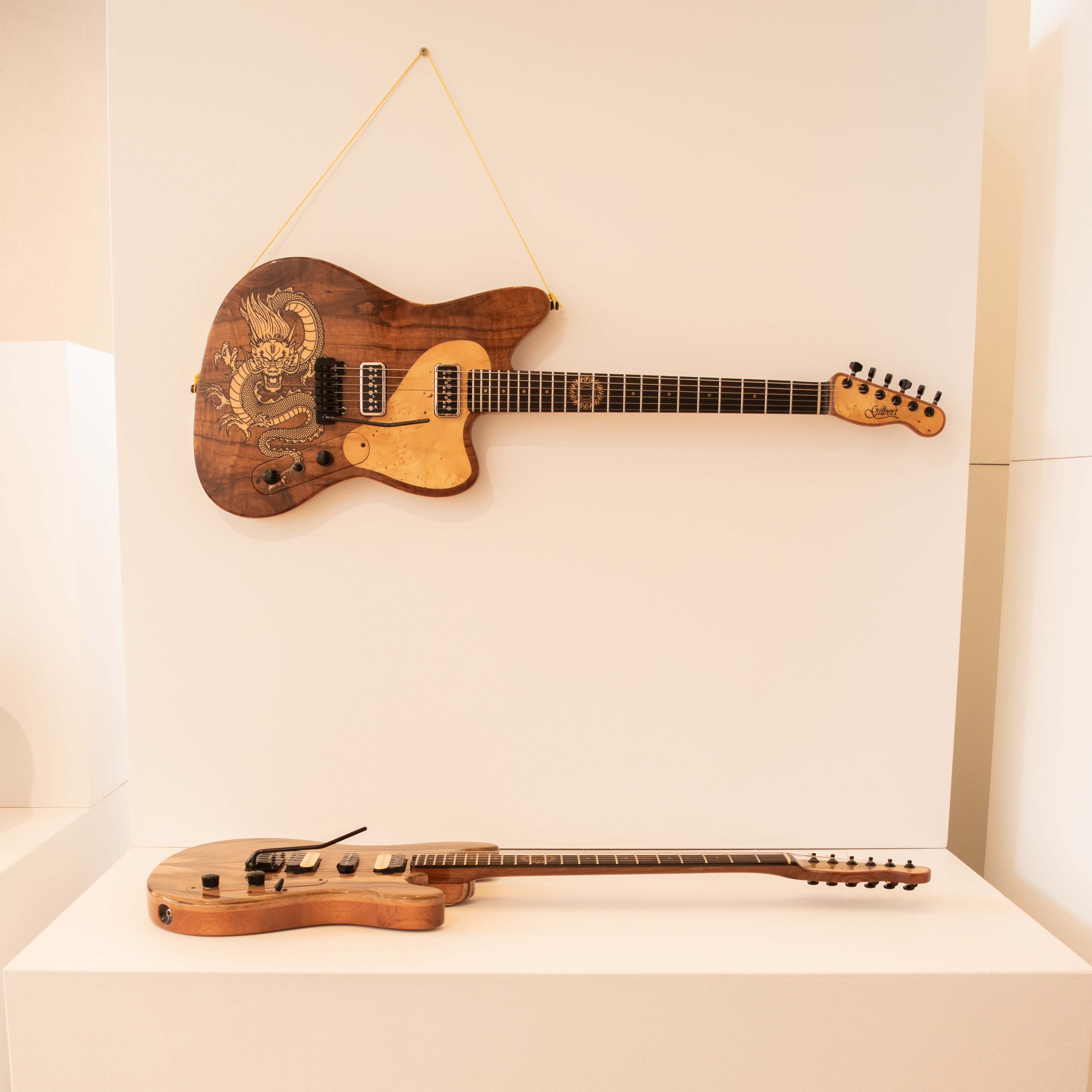
Surfmaster, BG Classic by Mark Gibert; photo by Juanny Tan.
Surfmaster + BG Classic
Mark Gilbert
Surfmaster
Tasmanian Blackheart top with inlaid Huon Pine dragon and inlaid Huon Pine scratchplate, Chambered Tasmanian Blackwood Body Macassar ebony fretboard with bone nut Tasmanian Blackwood neck bolted on with allen bolts into stainless steel inserts TV Jones T-Armond pickups, Gotoh locking machine heads, Gotoh Wilkinson tremolo, Schaller straplocks, Electrosocket jackplate CTS pots with Orange Drop capacitors and treble bleed circuit and 3 way toggle switch D’Addario 10-46 strings.
BG Classic
Tasmanian Blackheart Sassafras top, Chambered Tasmanian Blackwood Body Macassar ebony fretboard with bone nut Tasmanian Blackwood neck bolted on with allen bolts into stainless steel inserts, Suhr Thornbucker & Martin Landau pickups Hipshot, open back locking machine heads, Gotoh 510 steel block tremolo, Schaller straplocks, Electrosocket jackplate CTS pots with Orange Drop capacitors and treble bleed circuit and 5 way CRL blade switch D’Addario 10-46 strings.

Surfmaster; photo courtesy of Mark Gilbert.

BG Classic; photo courtesy of Mark Gilbert.

Surfmaster; photo by Juanny Tan.